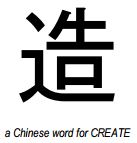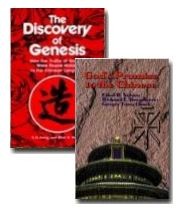Author : William Stewart, via lookinguntojesus.net

An Introduction To The Genesis Echo
Years ago, a good friend and fellow preacher of the gospel shared with me a sampling of Chinese characters which indicated a link between the ancient language and the book of Genesis. I thought the material was quite impressive, but could not have imagined at that time how detailed the Chinese language truly is with regard to the pre-Babel history of mankind.
In the fall of 2008, Yao Xin Xian, a student from China came to study at Queen’s University in Kingston, Ontario. In the process of our conversation between Toronto and Kingston, I secured an opportunity to show the 24 characters I was then aware of to him.
 His first response was apprehension as I proceeded to disassemble the Chinese image for CREATE. It was obvious that he had never considered the etymological significance of his native language. However, as we continued, looking at words such as BEGINNING, SATAN, RIGHTEOUSNESS, BOAT, TOWER and others, his caution turned to excitement, eventually causing him to exclaim that the link between the Chinese characters and the early Genesis story was “irrefutable.”
His first response was apprehension as I proceeded to disassemble the Chinese image for CREATE. It was obvious that he had never considered the etymological significance of his native language. However, as we continued, looking at words such as BEGINNING, SATAN, RIGHTEOUSNESS, BOAT, TOWER and others, his caution turned to excitement, eventually causing him to exclaim that the link between the Chinese characters and the early Genesis story was “irrefutable.”
 Yao Xin Xian’s reaction stirred in me the desire for more. Twenty-four characters were impressive, but surely that was not the extent of the connection between Chinese, the oldest continuous written language on the planet, and the record of Genesis. There must be a book, I thought. I found two, both from the pen of Ethel R. Nelson, with the aid of co-authors C.H. Kang (The Discovery of Genesis: How The Truths of Genesis Were Found Hidden in the Chinese Language) and Richard E. Broadberry & Ginger Tong Chock (God’s Promise to the Chinese). These resources shed light on several more Chinese images where the Genesis story was found in precise detail. And yet, I was still not satisfied.
Yao Xin Xian’s reaction stirred in me the desire for more. Twenty-four characters were impressive, but surely that was not the extent of the connection between Chinese, the oldest continuous written language on the planet, and the record of Genesis. There must be a book, I thought. I found two, both from the pen of Ethel R. Nelson, with the aid of co-authors C.H. Kang (The Discovery of Genesis: How The Truths of Genesis Were Found Hidden in the Chinese Language) and Richard E. Broadberry & Ginger Tong Chock (God’s Promise to the Chinese). These resources shed light on several more Chinese images where the Genesis story was found in precise detail. And yet, I was still not satisfied.
In the absence of any other books on the topic, I began my own etymological analysis of several Chinese characters, using an online Chinese-English dictionary.. I searched for additional links between the ancient language and Moses’ writing. I was astounded at what I found! Indeed, there were more. I do not know exactly how many Chinese words can be linked etymologically to the events and people of Genesis 1-11, but I know it is not a mere 24 or 40 characters. My research is currently approaching 100 Chinese images which tell in unmistakable detail the pre-Babel history of man as recorded in the Bible.
The Encyclopaedia Britannica suggests that the Chinese language “…began to develop in the early 2nd millennium BC. The earliest known inscriptions … date from the Shang (or Yin) dynasty (18th – 12th century BC), but, by then it was already a highly developed system, essentially similar to its present form.”1 This would place the origin of the ancient Chinese syntax within a few centuries of the dispersion which took place at the tower of Babel as recorded in Genesis 11.2
Why is the dispersion which took place at Babel important? From the time of the flood until the scattering of the nations from the tower of Babel, “…the whole earth was of one language, and of one speech…”, and the people remained together, fearing “…lest we be scattered abroad upon the face of the whole earth.”3 The next several verses in the Genesis record reveal that God confused the language of the people and scattered them abroad over the face of the whole earth. This is the origin of nations and languages. From Babel, a people departed and eventually settled in what we now call China, with their own distinct verbal language, and soon thereafter, they constructed a written code. That written code has in it a record of the pre-Babel history of mankind, as we shall see.
To further emphasize the significance of these details being found in the Chinese language, it is essential that we consider when the inspired Hebrew text was penned by Moses. The Exodus from Egypt took place in 1491 BC.4 Moses, at the age of eighty5 led the Israelites away from their bondage and towards the promised land of Canaan. He would die forty years later at the top of Mount Nebo.6 Thus, the book of Genesis, written by Moses, was penned sometime between 1491 and 1451 BC, as much as 796 years removed from the events at the tower of Babel, and an estimated 500 years after the development of the written Chinese language. Simply stated, the pre-Babel history of mankind was recorded in the Chinese language prior to Moses receiving and recording it by inspiration in the book of Genesis.
Perhaps you can appreciate my excitement about this material. Hidden in the pictures of the Chinese language, we find the details of creation, the garden of Eden, Cain and Abel, Noah and the flood, the tower of Babel, and more! In the articles to come, we will unveil this hidden historical record from antiquity.
- britannica.com/EBchecked/topic/691537/Chinese-writing
- The Timechart History of the World indicates the scattering of nations from Babel occurred in 2247 BC
- Genesis 11:1, 4, KJV
- See “Generations of Mankind” chart
- Exodus 7:7, KJV
- Deuteronomy 34:1, 7, KJV
Other Resources
Nelson, Ethel R., and C.H. Kang. The Discovery of Genesis: How the Truths of Genesis Were Found Hidden in the Chinese Language. St. Louis, MO : Concordia Publishing House, 1979.
Nelson, Ethel R., Richard E. Broadberry, and Ginger Tong Chock. God’s Promise to the Chinese. Dunlap, TN : Read Books Publishers, 1997.
MDBG Chinese-English Dictionary. usa.mdbg.net/chindict/chindict.php

